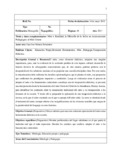Mostrar el registro sencillo del ítem
Mito o Realidad, la Filosofía de la Selva un Acercamiento Pedagógico al Mito Uitoto
| dc.contributor.advisor | Pérez Orozco, Carlos Enrique | |
| dc.coverage.spatial | cead_-_josé_celestino_mutis | spa |
| dc.creator | Mencía Hernández, Juan José | |
| dc.date.accessioned | 2018-05-17T20:02:16Z | |
| dc.date.available | 2018-05-17T20:02:16Z | |
| dc.date.created | 2018-05-15 | |
| dc.identifier.uri | https://repository.unad.edu.co/handle/10596/18085 | |
| dc.description.abstract | El mito, como elemento didáctico, adquiere una singular importancia, pues, ante la evidencia de la acelerada pérdida de esta riqueza cultural, desarrolla la función decisiva de salvaguardar conocimientos que, de otra manera, podrían perderse con la desaparición de los sabedores ancianos al no propiciar una sucesión discipular clara. Por esta razón, la etnoeducación debe enfrentar los desafíos epistemológicos que le plantea el mito, con propuestas que confronten los paradigmas impuestos y cambiarlos. Luego de evidenciar cómo el proceso de adaptar el mito a los lineamientos curriculares constituye uno de trasposición didáctica, se presenta una interpretación desde la hermenéutica del mito Uitoto del Árbol de la Abundancia, Moniya Amena, para identificar los contrastes entre la enunciación tradicional del mito y su transposición a los formatos de la escuela. Y desde allí se propondrá la aplicación de una trasposición didáctica a la inversa, en la que el saber enseñado sea el que se apropie del saber sabio. La tarea se abordará desde el horizonte del autor, siempre abierto a las resignificaciones de las vivencias sensibles que surgen de la grandiosidad del lenguaje en estas historias. | spa |
| dc.format | spa | |
| dc.format.mimetype | application/pdf | spa |
| dc.language.iso | spa | spa |
| dc.publisher | Universidad Nacional Abierta y a Distancia UNAD | spa |
| dc.title | Mito o Realidad, la Filosofía de la Selva un Acercamiento Pedagógico al Mito Uitoto | spa |
| dc.type | Proyecto aplicado | spa |
| dc.subject.keywords | Educación | spa |
| dc.subject.keywords | Ertnoeducación | spa |
| dc.subject.keywords | Hermenéutica | spa |
| dc.subject.keywords | Mitos – Escuela – Currículo | spa |
| dc.subject.keywords | Pedagogía | spa |
| dc.description.abstractenglish | The myth, as a didactic element, acquires a singular importance, because, in the face of the evidence of the accelerated loss of this cultural richness, it develops the decisive function of safeguarding knowledge that, otherwise, could be lost with the disappearance of the elderly knowledgeable propitiate a clear disciplic succession. For this reason, ethno-education must face the epistemological challenges posed by the myth, with proposals that confront the imposed paradigms and change them. After evidencing how the process of adapting the myth to the curricular guidelines constitutes one of didactic transposition, an interpretation is presented from the hermeneutics of the Uitoto myth of the Tree of Abundance, Moniya Amena, to identify the contrasts between the traditional enunciation of the myth and its transposition to school formats. And from there will be proposed the application of a didactic transposition to the inverse, in which the knowledge taught is the one that appropriates the wise knowledge. The task will be approached from the horizon of the author, always open to the resignifications of the sensitive experiences that arise from the grandeur of language in these stories | spa |
| dc.subject.category | Licenciatura en Etnoeducación | spa |
| dc.rights.accesRights | info:eu-repo/semantics/openAccess | spa |
| dc.rights.acceso | Abierto (Texto Completo) | spa |















